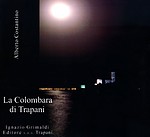By the Association
“SALVIAMO LA COLOMBAIA” TRAPANI
THE COLOMBAIA
The monumental work stands on a small island placed in front of the port of Trapani, originally named “Peliade” tower.
If the origins of Trapani are shrouded by the legend, not unlike we can say of the “Colombaia”.
Many are the versions come from several authors of ancient times, but when we try to find one closer to
the truth, we feel like to be in a spot because we aren’t in possession of documents and real stories to let
us say we are right.
Consequently we are obliged to give only one version got by matching up of concordances between some authors and what we have considered carefully in confronting with the existing reality of the sites.
HISTORICAL HINTS
We got to know about some significant dates, in order to have a careful reading of the work, these are
listed below:
- The first building, a tower-lighthouse was made (according to some historians) 480 years before
Christ, by Trapanese people allied to the Carthaginians in the war against Greek “Sicilioti”, whose
task was to create a reference point for Carthaginian ships.
- In 260 b. C. during the first Punic war, Amilcare Barca built there a tower and a military barracks
in place of the pre-existing lighthouse.
- In 249 b. C. the Romans, leaded by the consul P. Claudio Pulcro came into possession of the
fortress, for a short time. The Carthaginians leaded by Aderbale won the fortress back.
- In 241 b. C., after the successful battle of the Egadi islands, it was captured by the Romans, whom sticked around there until the vandal invasions.
- About the expanded, transformed factories built in the following ages, there have not been detailed documentation, but we can see clearly the modern hand grafted over the antique.
- In 1076, the Count Ruggiero, once succeeded in the purpose of conquering Trapani, he improved
its fortifications and recovered the Colombaia.
- In 1360, the Queen Costanza, Federico Ventimiglia’s wife, came from Catalonia and went ashore
on the Colombaia where she settled down.
- In 1408 become King Martino I, by his command, a refurbishment of the factories of the Colombaia was done.
- Reigning Filippo III king of Spain and of Sicily, during the war broken out in his kingdom, the Colombaia was restructured and more armed.
- In 1671 during the reign of Carlo II of Austria, was built, furthermore to the tower and the oval,
the lower battery looking at the port.
- In 1848 Trapani, that had taken part in the revolts of 1820, was one of the firs towns in Sicily to
rise up against the Borboni, and in the 1848 all the prisons were full, so the Trapanese patriots
were locked in the Colombaia, used as a jail.
- In May 1965, with the construction of new prison of San Giuliano, all the prisoners were moved
to the new site and the Colombaia came back to be that place of abandon and solitude that was one
of the prerogatives of its long existence.
HISTORICAL-STRUCTURAL ANALYSIS OF THE EXISTING
The castle, standing on the small island, exposes its smallest façade to those who are watching it from the
port, giving more the sensation of a stronghold than of a grand complex.
He who is going to visit it, gradually approaching it, realize how massive is the building itself and of the
great changes undergone during the centuries.
The tour around the fortress can be done only by a watercraft, because it is half-surrounded at east by a
strip of land and the rest by the water of Mediterranean Sea.
An ancient manuscript that we can not guarantee as true authenticity, relates:
“The first building was octagonal shaped, thirty two meters high, eight meters of diameter, and was fenced by a wall of elliptical shape on the fall of the ditch”.
Versione Italiana


























